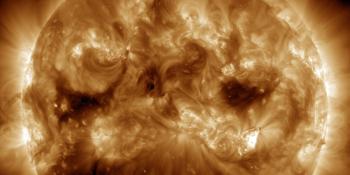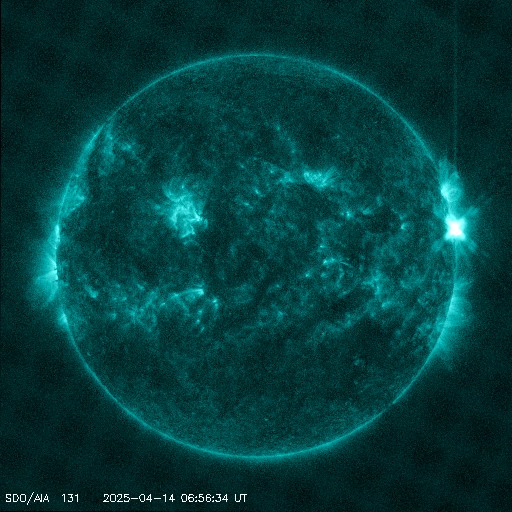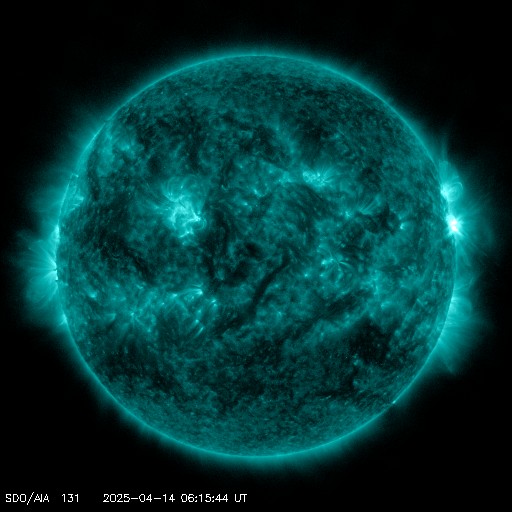Viewing archive of Monday, 30 July 2012
Solar activity report
Any mentioned solar flare in this report has a scaling factor applied by the Space Weather Prediction Center (SWPC). Because of the SWPC scaling factor, solar flares are reported as 42% smaller than for the science quality data. The scaling factor has been removed from our archived solar flare data to reflect the true physical units.
Report of Solar-Geophysical Activity 2012 Jul 30 2200 UTCPrepared by the NOAA © SWPC and processed by SpaceWeatherLive.com
Joint USAF/NOAA Report of Solar and Geophysical Activity
SDF Number 212 Issued at 2200Z on 30 Jul 2012IA. Analysis of Solar Active Regions and Activity from 29-2100Z to 30-2100Z
Solar activity was moderate. Region 1532 (S19E14) and
new Region 1536 (S21E26) were responsible for the highest flares
during the period: a C8/1n flare at 30/1403Z and an M1/Sn at
30/1548Z respectively. Analysis with magnetogram and white light
imagery determined that Region 1532 was actually two separate
regions. New Region 1536 now encompasses the two larger spots
trailing Region 1532. Another new spot group rotated onto the
northeast limb and was numbered Region 1535 (N18E64). No
Earth-directed coronal mass ejections were observed during the
reporting period.
IB. Solar Activity Forecast
Solar activity is expected to be low
with a chance for M-class flares. Regions 1532 and 1536 are the
most likely Regions to produce M-class activity.
IIA. Geophysical Activity Summary 29-2100Z to 30-2100Z
The geomagnetic field was quiet to active with intervals of minor to
major storming observed at high latitudes during the periods ranging
from 30/0600 - 0900Z and from 30/1200 - 1800Z. Solar wind speed,
measured at the ACE spacecraft, increased from approximately 350 to
450 km/s, while the Bz component of the interplanetary magnetic
field had prolonged southward intervals near -7 nT.
IIB. Geophysical Activity Forecast
The geomagnetic field is
expected to be quiet to unsettled on day 1 (31 July). Mostly quiet
conditions are expected on day 2 (01 August). By approximately
mid-day on day 3 (02 August), quiet to unsettled conditions are
expected with isolated active periods possible due to effects from
the 28 July CME.
III. Event Probabilities 31 Jul to 02 Aug
| Class M | 35% | 35% | 35% |
| Class X | 05% | 05% | 05% |
| Proton | 05% | 05% | 05% |
| PCAF | Green | ||
IV. Penticton 10.7 cm Flux
Observed 30 Jul 136 Predicted 31 Jul-02 Aug 135/135/140 90 Day Mean 30 Jul 126
V. Geomagnetic A Indices
Observed Afr/Ap 29 Jul 006/006 Estimated Afr/Ap 30 Jul 009/012 Predicted Afr/Ap 31 Jul-02 Aug 008/010-006/006-008/010
VI. Geomagnetic Activity Probabilities 31 Jul to 02 Aug
| A. Middle Latitudes | |||
|---|---|---|---|
| Active | 10% | 05% | 20% |
| Minor storm | 05% | 01% | 10% |
| Major-severe storm | 01% | 01% | 01% |
| B. High Latitudes | |||
|---|---|---|---|
| Active | 15% | 15% | 15% |
| Minor storm | 20% | 15% | 25% |
| Major-severe storm | 10% | 05% | 30% |
All times in UTC
Current data suggests there is a slight possibility for aurora to appear at the following high latitude regions in the near future
Iqaluit, NUNuuk
Reykjavik
Latest news
Latest forum messages
2025/04/12-13 Filament CMEs 2025/04/16 G2 Watch 41AR 4055 99Incoming & Unnumbered Active Regions 1700Unspecified geomagnetic activity 2258Potential AR4062 8
More topicsSupport SpaceWeatherLive.com!
A lot of people come to SpaceWeatherLive to follow the Sun's activity or if there is aurora to be seen, but with more traffic comes higher server costs. Consider a donation if you enjoy SpaceWeatherLive so we can keep the website online!

Latest alerts
Monday, 14 April 2025
23:15 UTC - Geomagnetic activity
Active geomagnetic conditions (Kp4) Threshold Reached: 23:01 UTC
07:09 UTC - Solar flare
Moderate M4.28 flare from sunspot region 4055
06:48 UTC - Radio Blackout
Minor R1 radio blackout in progress (≥M1 - current: M1.53)
06:24 UTC - Solar flare
Moderate M1.49 flare from sunspot region 4055
06:06 UTC - Radio Blackout
Minor R1 radio blackout in progress (≥M1 - current: M1.16)
Space weather facts
| Last X-flare | 2025/03/28 | X1.1 |
| Last M-flare | 2025/04/14 | M4.2 |
| Last geomagnetic storm | 2025/04/06 | Kp5 (G1) |
| Spotless days | |
|---|---|
| Last spotless day | 2022/06/08 |
| Monthly mean Sunspot Number | |
|---|---|
| March 2025 | 134.2 -20.4 |
| April 2025 | 132.1 -2.1 |
| Last 30 days | 130.6 -13.6 |





